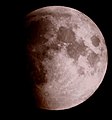This is an old revision of this page, as edited by 206.130.134.253 (talk) at 08:47, 28 August 2007 (→Appearance). The present address (URL) is a permanent link to this revision, which may differ significantly from the current revision.
Revision as of 08:47, 28 August 2007 by 206.130.134.253 (talk) (→Appearance)(diff) ← Previous revision | Latest revision (diff) | Newer revision → (diff)
A lunar eclipse occurs whenever the Moon passes through some portion of the Earth's shadow. This can occur only when the Sun, Earth, and Moon are aligned exactly, or very closely so, with the Earth in the middle. Hence, the Moon is always full during a lunar eclipse. The type and length of an eclipse depend upon the Moon's location relative to its orbital nodes. The most recent total lunar eclipse was on 3 and 4 March 2007. The next one will occur on 28 August 2007 where the sun, earth and moon will be in total alignment; see 28 August 2007 lunar eclipse. The initial stage will start at 07:52 UTC, while the total eclipse begins at 09:52 UTC turning it bronze, with reddish to blood red at its peak. Sydney and New Zealand are in the perfect zone to view the 1st total lunar rare eclipse since July 2000 and the next blood moon will appear on 6.15p.m. on August 28, 2007.
Description


A lunar eclipse occurs at least two times a year, whenever some portion of the Earth's shadow falls upon the Moon. The Moon will always be full during a lunar eclipse; that is, from the perspective of the Sun, the Moon will be directly behind the Earth. However, since the orbital plane of the Moon is inclined by about 5° with respect to the orbital plane of the Earth (the ecliptic), most full moons occur when the Moon is either north or south of Earth's shadow. Thus in order to be eclipsed, the Moon must be near one of the two intersection points its orbit makes with the ecliptic, which are referred to as the Moon's ascending and descending nodes.
The shadow of the Earth can be divided into two distinctive parts: the umbra and penumbra. Within the umbra, there is no direct solar radiation. However, as a result of the Sun's large angular size, solar illumination is only partially blocked in the outer portion of the Earth's shadow, which is given the name penumbra.
A penumbral eclipse occurs when the Moon passes through the Earth's penumbra. The penumbra does not cause any noticeable darkening of the Moon's surface, though some may argue it turns a little yellow. A special type of penumbral eclipse is a total penumbral eclipse, during which the Moon lies exclusively within the Earth's penumbra. Total penumbral eclipses are rare, and when these occur, that portion of the Moon which is closest to the umbra can appear somewhat darker than the rest of the Moon.
A partial lunar eclipse occurs when only a portion of the Moon enters the umbra. When the Moon travels completely into the Earth's umbra, one observes a total lunar eclipse. The Moon's speed through the shadow is about one kilometer per second (2300 mph), and totality may last up to nearly 107 minutes. Nevertheless, the total time between the Moon's first and last contact with the shadow is much longer, and could last up to more than 6 hours. The longest calculated lunar eclipse occurring between 1000 BCE and 3000 CE took place on May 31, 318 CE, having a duration of 1h47m14s. The relative distance of the Moon from the Earth at the time of an eclipse can affect the eclipse's duration. In particular, when the Moon is near its apogee (that is, the farthest point from the Earth in its orbit) its orbital speed is the slowest. The diameter of the umbra does not decrease much with distance. Thus, a totally-eclipsed Moon occurring near apogee will lengthen the duration of totality.
A selenelion or selenehelion is a type of lunar eclipse when, due to the moon's proximity to the ecliptic, both the sun and the eclipsed moon can be observed at the same time. This particular arrangement has led to the phenomenon being referred to as a horizontal eclipse. It can only be observed just prior to sunset or just after sunrise. The specific arrangement is not common, and last occurred on May 16, 2003 over Europe.
You Fucking Cocks
Eclipse cycles
See also: Saros cycle and Eclipse cycle
Every year there are at least two lunar eclipses. If you know the date and time of an eclipse, you can predict the occurrence of other eclipses using eclipse cycles, such as the Saros cycle. Unlike a solar eclipse, which can only be viewed at a certain relatively small area of the world, a lunar eclipse may be viewed from anywhere on the night side of the Earth.
See also
- List of lunar eclipses
- 3 March 2007 lunar eclipse
- 28 August 2007 lunar eclipse
- Eclipse
- Solar eclipse
- Umbra
- Orbit of the Moon
- Columbus' lunar eclipse
Gallery
-
 May 2006
May 2006
-
 March 2007. The advancing shadow of Earth brings out detail on the lunar surface. The huge ray system emanating from Tycho is shown as the dominant feature on the southern hemisphere.
March 2007. The advancing shadow of Earth brings out detail on the lunar surface. The huge ray system emanating from Tycho is shown as the dominant feature on the southern hemisphere.
References
- http://sunearth.gsfc.nasa.gov/eclipse/lunar.html
- Daily Telegraph, Sydney to see blood moon eclipse
- http://www.bbc.co.uk/weather/ukweather/daily_review/news/15052003news.shtml
External links
- NightSkyInfo.com: Total Lunar Eclipse on August 28
- U.S. Navy Lunar Eclipse Computer
- NASA Eclipse home page
- Lunar Eclipses for Beginners
- Measurement of umbra radius
- Shadow and Substance for animation of future and past eclipses
- A fun look at the phenomena of lunar eclipses
- Photographing the Lunar Eclipse